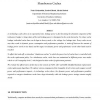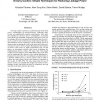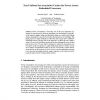9 search results - page 1 / 2 » Controlling leakage power with the replacement policy in slu... |
CF
2005
ACM
13 years 7 months ago
2005
ACM
As technology scales down at an exponential rate, leakage power is fast becoming the dominant component of the total power budget. A large share of the total leakage power is diss...
ISCA
2002
IEEE
13 years 10 months ago
2002
IEEE
On-chip caches represent a sizable fraction of the total power consumption of microprocessors. Although large caches can significantly improve performance, they have the potential...
ISLPED
2005
ACM
13 years 10 months ago
2005
ACM
Leakage power reduction in cache memories continues to be a critical area of research because of the promise of a significant pay-off. Various techniques have been developed so fa...
MICRO
2002
IEEE
13 years 4 months ago
2002
IEEE
On-chip caches represent a sizeable fraction of the total power consumption of microprocessors. Although large caches can significantly improve performance, they have the potentia...
EUC
2004
Springer
13 years 10 months ago
2004
Springer
Abstract. Power consumption is becoming one of the most important constraints for microprocessor design in nanometer-scale technologies. Especially, as the transistor supply voltag...



